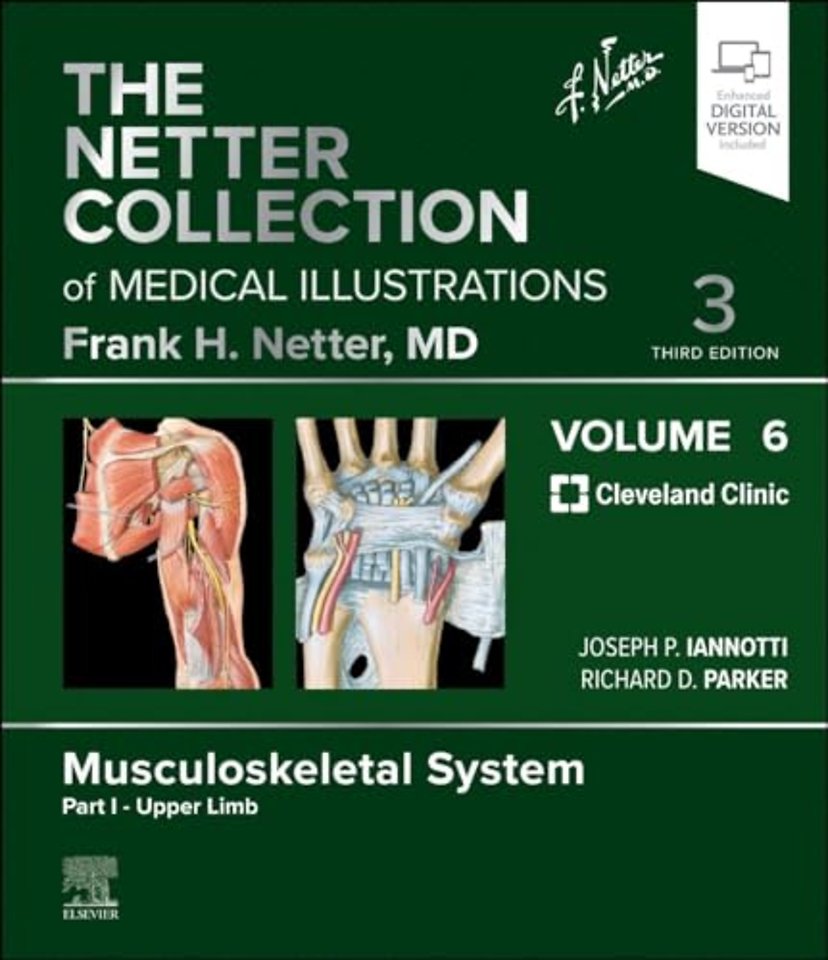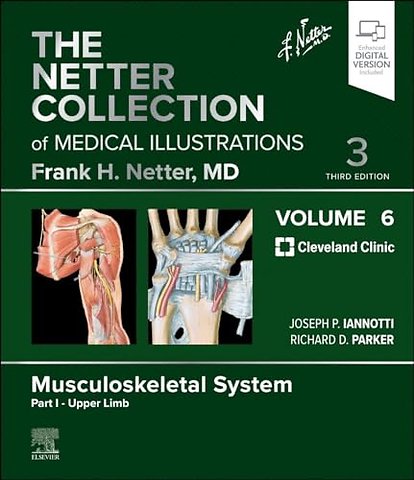SECTION 1 SHOULDER<br>Anatomy<br>1.1 Scapula and Humerus: Posterior View<br>1.2 Scapula and Humerus: Anterior View<br>1.3 Clavicle<br>1.4 Ligaments<br>1.5 Glenohumeral Arthroscopic Anatomy<br>1.6 Glenohumeral Arthroscopic Anatomy (Continued)<br>1.7 Anterior Muscles<br>1.8 Anterior Muscles: Cross Section<br>1.9 Posterior Muscles<br>1.10 Posterior Muscles: Cross Section<br>1.11 Muscles of Rotator Cuff<br>1.12 Muscles of Rotator Cuff: Cross Sections<br>1.13 Axilla Dissection: Anterior View<br>1.14 Axilla: Posterior Wall and Cord<br>1.15 Deep Neurovascular Structures and Intervals<br>1.16 Axillary and Brachial Arteries<br>1.17 Axillary Artery and Anastomoses Around Scapula<br>1.18 Brachial Plexus<br>1.19 Peripheral Nerves: Dermatomes<br>1.20 Peripheral Nerves: Sensory Distribution and Neuropathy in Shoulder<br>Clinical Problems and Correlations<br>Fractures and Dislocation<br>1.21 Proximal Humeral Fractures: Neer Classification<br>1.22 Proximal Humeral Fractures: Two-Part Tuberosity Fracture<br>1.23 Proximal Humeral Fractures: Two Part Surgical Neck Fracture and Humeral Head Dislocation<br>1.24 Proximal Humeral Fractures: Valgus-Impacted Four-Part Fracture<br>1.25 Proximal Humeral Fractures: Displaced Four-Part Fractures with Articular Head Fracture<br>1.26 Proximal Humeral Fractures: Reverse Total Shoulder Replacement<br>1.27 Anterior Dislocation of Glenohumeral Joint: Anterior Dislocation Types and Stimson Maneuver<br>1.28 Anterior Dislocation of Glenohumeral Joint: Pathologic Lesions<br>1.29 Anterior Dislocation of Glenohumeral Joint: Imaging<br>1.30 Posterior Dislocation of Glenohumeral Joint<br>1.31 Posterior Dislocation of Glenohumeral Joint (Continued)<br>1.32 Acromioclavicular and Sternoclavicular Dislocation<br>1.33 Fractures of the Clavicle<br>1.34 Fractures of the Clavicle and Scapula<br>Common Soft Tissue Disorders<br>1.35 Calcific Tendonitis<br>1.36 Frozen Shoulder: Clinical Presentation<br>1.37 Frozen Shoulder: Risk Factors and Diagnostic Tests<br>1.38 Biceps, Tendon Tears, and SLAP Lesions: Presentation and Physical Examination<br>1.39 Biceps, Tendon Tears, and SLAP Lesions: Types of Tears<br>1.40 Acromioclavicular Joint Arthritis<br>1.41 Impingement Syndrome and the Rotator Cuff: Presentation and Diagnosis<br>1.42 Impingement Syndrome and the Rotator Cuff: Radiologic and Arthroscopic Imaging<br>1.43 Rotator Cuff Tears: Physical Examination<br>1.44 Supraspinatus and Infraspinatus Rotator Cuff Tears: Imaging<br>1.45 Supraspinatus and Infraspinatus Rotator Cuff Tears: Surgical Management<br>1.46 Supraspinatus and Infraspinatus Cuff Tear: Surgical Management Superior Capsular Reconstruction and Balloon Arthroplasty<br>1.47 Supraspinatus and Infraspinatus Cuff Tear: Surgical Management Latissimus and Trapezius Transfers<br>1.48 Management of Subscapularis Rotator Cuff Tears<br>1.49 Management of Irreparable Subscapularis Tears: Pectoralis and Latissimus Transfers<br>1.50 Osteoarthritis of the Glenohumeral Joint<br>1.51 Osteoarthritis of the Glenohumeral Joint: Surgical Imaging<br>1.52 Avascular Necrosis of the Humeral Head<br>1.53 Rheumatoid Arthritis of the Glenohumeral Joint: Radiographic Presentations and Treatment Options<br>1.54 Rheumatoid Arthritis of the Glenohumeral Joint: Conservative Humeral Head Surface Replacement<br>1.55 Rotator Cuff–Deficient Arthritis (Rotator Cuff Tear Arthropathy): Physical Findings and Appearance<br>1.56 Rotator Cuff–Deficient Arthritis (Rotator Cuff Tear Arthropathy): Radiographic Findings<br>1.57 Rotator Cuff–Deficient Arthritis (Rotator Cuff Tear Arthropathy): Radiographic Findings (Continued)<br>1.58 Neurologic Conditions of the Shoulder: Suprascapular Nerve<br>1.59 Neurologic Conditions of the Shoulder: Long Thoracic and Spinal Accessory Nerves<br>Amputation<br>1.60 Amputation of Upper Arm and Shoulder, 61<br>Injections, Basic Rehabilitation, and Surgical Approaches<br>1.61 Shoulder Injections<br>1.62 Basic, Passive, and Active-Assisted Range of Motion Exercises<br>1.63 Basic Shoulder-Strengthening Exercises<br>1.64 Basic Shoulder Strengthening Exercises (Continued)<br>1.65 Common Surgical Approaches to the Shoulder<br><br>SECTION 2 UPPER ARM AND ELBOW<br>Anatomy<br>2.1 Topographic Anatomy<br>2.2 Anterior and Posterior Views of Humerus<br>2.3 Elbow Joint: Bones<br>2.4 Elbow Joint: Radiographs<br>2.5 Elbow Ligaments: Anterior Views<br>2.6 Elbow Ligaments: Lateral and Medial Views<br>2.7 Muscles Origins and Insertions<br>2.8 Muscles: Anterior Views<br>2.9 Muscles: Posterior Views<br>2.10 Cross Sectional Anatomy of Upper Arm<br>2.11 Cross Sectional Anatomy of Elbow<br>2.12 Cutaneous Nerves and Superficial Veins<br>2.13 Cutaneous Innervation<br>2.14 Musculocutaneous Nerve of Upper Arm and Elbow<br>2.15 Radial Nerve<br>2.16 Brachial Artery In Situ<br>2.17 Brachial Artery and Anastomoses around Elbow<br>Clinical Problems and Correlations<br>2.18 Physical Examination and Range of Motion<br>Fractures and Dislocation<br>2.19 Humeral Shaft Fractures<br>2.20 Injury to the Elbow<br>2.21 Fracture of Distal Humerus<br>2.22 Fracture of Distal Humerus: Total Elbow Arthroplasty<br>2.23 Fracture of Distal Humerus: Capitellum<br>2.24 Fracture of Head and Neck of Radius<br>2.25 Fracture of Head and Neck of Radius: Imaging<br>2.26 Fracture of Olecranon<br>2.27 Dislocation of Elbow Joint<br>2.28 Dislocation of Elbow Joint (Continued)<br>2.29 Injuries in Children: Supracondylar Humerus Fractures<br>2.30 Injuries in Children: Elbow<br>2.31 Injuries in Children: Subluxation of Radial Head<br>2.32 Complications of Fracture<br>Common Soft Tissue Disorders<br>2.33 Arthritis: Open and Arthroscopic Elbow Debridement<br>2.34 Arthritis: Elbow Arthroplasty Options<br>2.35 Arthritis: Imaging of Total Elbow Arthroplasty Designs<br>2.36 Cubital Tunnel Syndrome: Sites of Compression<br>2.37 Cubital Tunnel Syndrome: Clinical Signs and Treatment<br>2.38 Epicondylitis and Olecranon Bursitis<br>2.39 Rupture of Biceps and Triceps Tendon<br>2.40 Medial Elbow and Posterolateral Rotatory Instability Tests<br>2.41 Osteochondritis Dissecans of the Elbow<br>2.42 Osteochondrosis of the Elbow (Panner Disease)<br>2.43 Congenital Dislocation of Radial Head<br>2.44 Congenital Radioulnar Synostosis<br>Injections, Basic Rehabilitation, and Surgical Approaches<br>2.45 Common Elbow Injections and Basic Rehabilitation<br>2.46 Surgical Approaches to the Upper Arm and Elbow<br>2.47 Surgical Approaches to the Upper Arm and Elbow (Continued)<br><br>SECTION 3 FOREARM AND WRIST<br>Anatomy<br>3.1 Topographic Anatomy<br>3.2 Bones of Forearm<br>3.3 Bones of Wrist<br>3.4 Radiologic Findings of Wrist<br>3.5 Ligaments of Wrist<br>3.6 Arthroscopy of Wrist<br>3.7 Muscles of Forearm (Superficial Layer): Anterior View<br>3.8 Muscles of Forearm (Intermediate and Deep Layers): Anterior View<br>3.9 Muscles of Forearm (Superficial and Deep Layers): Posterior View<br>3.10 Cross-Sectional Anatomy of Right Forearm<br>3.11 Cross-Sectional Anatomy of Wrist<br>3.12 Muscles of Forearm: Origins and Insertions<br>3.13 Blood Supply of Forearm<br>3.14 Median Nerve of Forearm<br>3.15 Ulnar Nerve of Forearm<br>3.16 Cutaneous Nerves of Forearm<br>Clinical Problems and Correlations<br>3.17 Carpal Tunnel Syndrome<br>3.18 Cubital Tunnel Syndrome<br>3.19 Fracture of Distal Radius: Colles Fracture<br>3.20 Fracture of Distal Radius: Radiology<br>3.21 Fracture of Distal Radius: Closed Reduction and Plaster Cast Immobilization of Colles Fracture<br>3.22 Fracture of Distal Radius: Radiology of Open Reduction and Internal Fixation<br>3.23 Fracture of Scaphoid: Presentation and Classification<br>3.24 Fracture of Scaphoid: Blood Supply and Treatment<br>3.25 Fracture of Scaphoid: Radiology<br>3.26 Fracture of Hamulus of Hamate<br>3.27 Dislocation of Carpus: Presentation and Treatment<br>3.28 Dislocation of Carpus: Radiology<br>3.29 Fracture of Both Forearm Bones<br>3.30 Fracture of Shaft of Ulna<br>3.31 Fracture of Shaft of Radius<br>3.32 Ganglion of Wrist<br>3.33 De Quervain Disease<br>3.34 Rheumatoid Arthritis of Wrist<br>3.35 Arthritis of Wrist<br>3.36 Kienböck Disease<br>3.37 Radial Longitudinal Deficiency: Forearm Manifestations<br>3.38 Radial Longitudinal Deficiency: Type II Hypoplastic Thumb<br><br>SECTION 4 HAND AND FINGER<br>Anatomy<br>4.1 Topographic Anatomy: Anterior View<br>4.2 Topographic Anatomy: Posterior View<br>4.3 Metacarpophalangeal and Interphalangeal Ligaments<br>4.4 Definitions of Hand Motion<br>4.5 Flexor and Extensor Tendons in Fingers<br>4.6 Flexor and Extensor Zones and Lumbrical Muscles<br>4.7 Wrist and Hand: Deep Dorsal Dissection<br>4.8 Wrist and Hand: Intrinsic Muscles<br>4.9 Spaces, Bursae, and Tendon and Lumbrical Sheaths of Hand<br>4.10 Wrist and Hand: Palmar Dissections<br>4.11 Vascular Supply of the Hand and Finger<br>4.12 Ulnar Nerve of Hand<br>4.13 Median Nerve of Hand<br>4.14 Radial Nerve of Hand<br>4.15 Skin and Subcutaneous Fascia: Anterior View<br>4.16 Skin and Subcutaneous Fascia: Posterior View<br>4.17 Lymphatic Drainage<br>4.18 Digits: Sectional Anatomy<br>4.19 Thumb: Sectional Anatomy<br>Degenerative and Systemic Disorders<br>4.20 Hand Involvement in Osteoarthritis<br>4.21 Hand Involvement in Rheumatoid Arthritis and Psoriatic Arthritis<br>4.22 Hand Involvement in Gouty Arthritis and Reiter Syndrome<br>4.23 Deformities of Thumb Joints: Metacarpophalangeal Deformities<br>4.24 Deformities of Thumb Joints: Carpometacarpal Osteoarthritis<br>4.25 Deformities of Thumb Joints: Ligament Replacement and Tendon Interposition Arthroplasty<br>4.26 Deformities of the Metacarpophalangeal Joints: Implant Resection Arthroplasty<br>4.27 Deformities of the Metacarpophalangeal Joints: Implant Resection Arthroplasty (Continued)<br>4.28 Deformities of the Metacarpophalangeal Joints: Implant Resection Arthroplasty (Continued)<br>4.29 Deformities of the Metacarpophalangeal Joints: Modular versus Implant Resection Arthroplasty<br>4.30 Deformities of Interphalangeal Joint: Radiographic Findings<br>4.31 Deformities of Interphalangeal Joint: Swan Neck and Boutonniere<br>4.32 Deformities of Interphalangeal Joint: Implant Resection Arthroplasty<br>4.33 Deformities of Interphalangeal Joint: Modular Versus Implant Resection Arthroplasty<br>4.34 Dupuytren Contracture: Presentation and Treatment<br>4.35 Dupuytren Contracture: Surgical Approach to Finger<br>Infections and Tendon Disorders<br>4.36 Cellulitis and Abscess<br>4.37 Tenosynovitis and Infection of Fascial Space<br>4.38 Tenosynovitis and Infection of Fascial Space (Continued)<br>4.39 Infected Wounds<br>4.40 Infection of Deep Compartments of Hand<br>4.41 Lymphangitis<br>4.42 Bier Block Anesthesia<br>4.43 Thumb Carpometacarpal Injection, Digital Block, and Flexor Sheath Injection<br>4.44 Tendon Disorders: Trigger Finger and Jersey Finger<br>4.45 Tendon Disorders: Repair of Tendon<br>Fractures and Dislocations<br>4.46 Fracture of Metacarpal Neck and Shaft<br>4.47 Fracture of Thumb Metacarpal Base<br>4.48 Fracture of Proximal and Middle Phalanges<br>4.49 Management of Fracture of Proximal and Middle Phalanges<br>4.50 Special Problems in Fracture of Middle and Proximal Phalanges<br>4.51 Thumb Ligament Injury and Dislocation<br>4.52 Carpometacarpal and Metacarpophalangeal Joint Injury<br>4.53 Dorsal and Palmar Interphalangeal Joint Dislocations<br>4.54 Treatment of Dorsal Interphalangeal Joint Dislocation<br>4.55 Injuries to the Fingertip<br>4.56 Rehabilitation after Injury to Hand and Fingers<br>Amputation and Replantation<br>4.57 Amputation of Phalanx<br>4.58 Amputation of Thumb and Deepening of Thenar Web Cleft<br>4.59 Thumb Lengthening Post Amputation<br>4.60 Microsurgical Instrumentation for Replantation<br>4.61 Debridement, Incisions, and Repair of Bone in Replantation of Digit<br>4.62 Repair of Blood Vessels and Nerves<br>4.63 Postoperative Dressing and Monitoring of Blood Flow<br>4.64 Replantation of Avulsed Thumb and Midpalm<br>4.65 Lateral Arm Flap for Defect of Thumb Web<br>4.66 Transfer of Great Toe to Thumb Site<br>Selected References

